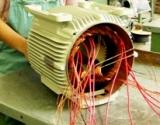Electrical insulating compounds
 Compounds are insulating compounds that are liquid during use, which then solidify. Insulation compounds do not contain solvents.
Compounds are insulating compounds that are liquid during use, which then solidify. Insulation compounds do not contain solvents.
According to their purpose, electrical insulating compounds are divided into impregnating and casting. The first are used to impregnate the windings of electrical machines and devices, the second — to fill cavities in cable sleeves, as well as in electrical devices and devices (transformers, chokes, etc.).
Electrical insulating compounds can be thermoset (do not soften after curing) or thermoplastic (soften upon subsequent heating). Thermosetting compounds include compounds based on epoxy, polyester and some other resins. To thermoplastic - compounds based on bitumen, wax dielectrics and thermoplastic polymers (polystyrene, polyisobutylene, etc.). Impregnating and casting mixtures based on bitumen in terms of heat resistance belong to class A (105 ° C), and some to class Y (up to 90 ° C) and lower.
MBK compounds are made on the basis of methacrylic esters and are used as impregnating and pouring compounds.After hardening at 70 — 100 ° C (and with special hardeners at 20 ° C) they are thermosetting substances that can be used in the temperature range from -55 to + 105 ° C.
MBK compounds have low volume shrinkage (2 — 3%) and have high permeability. They are chemically inert to metals but react with rubber.
Compounds KGMS-1 and KGMS-2 in the initial state are solutions of polyesters in monomeric styrene with the addition of hardeners. In the final (working) state, they are solid thermoset dielectrics that can be used for a long time in the temperature range from -60 ° to + 120 ° C (heat resistance class E). When heated to 220 — At 250 ° C, hardened compounds MBK and KGMS soften to some extent.
Rapid hardening of KGMS compounds occurs at temperatures of 80 — 100 ° C. At 20 ° C, the hardening process of these compounds is slow. The initial impregnating mass (mixture of polyester with styrene and hardeners) is prepared at room temperature. CGMS compounds cause oxidation of exposed copper wires.
Epoxy and epoxy-polyester compounds are characterized by low volumetric shrinkage (0.2 - 0.8%). In their original state, they are mixtures of epoxy resin with polyester and hardeners (maleic or phthalic anhydrides and other substances), and sometimes fillers are added (powdered quartz, etc.).
Curing of epoxy-polyester compounds can be carried out both at elevated (100 — 120 ° C) and at room temperature (compound K-168, etc.). In the final (working) state, epoxy and epoxy-polyester compounds are thermoreactive substances that can work for a long time in the temperature range from -45 to +120 — 130 ° C (heat resistance classes E and B).The frost resistance of these compounds in thin layers (1-2 mm) reaches -60 ° C. The advantages of epoxy compounds are good adhesion to metals and other materials (plastics, ceramics), high resistance to water and fungi.
Epoxy and epoxy-polyester compounds are used as casting insulation (instead of porcelain and metal boxes) for current and voltage transformers, chokes and other blocks of electrical apparatus and devices. In these cases, the liquid compound is poured into metal molds, which are then removed.
The disadvantage of many epoxy and epoxy-polyester compounds is the short life (from 20 to 24 minutes) after preparation, after which the compound acquires a high viscosity, which excludes further use.
All cold potting mixes are characterized by low volume shrinkage and do not require pre-heating to produce the original potting mix. Such compounds include masses based on epoxy resins (compound K-168, etc.), RGL compounds based on resorcinol-glyceride ether, compound KHZ-158 (VEI) — based on bitumen and resins, rosin, and others.
Silicon-organic compounds have the highest heat resistance, but require high temperatures (150 — 200 ° C) for its hardening. They are used for impregnation and casting of windings of electrical machines and devices that work for a long time at 180 ° C (heat resistance class H).
Diisocyanate compounds are distinguished by the highest frost resistance (-80 ° C), but in terms of heat resistance, they belong to class E (120 ° C).
